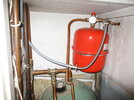- Joined
- 28 Nov 2023
- Messages
- 24
- Reaction score
- 0
- Country

Hello,
I live in a two floor semi with a gravity fed conventional gas fired boiler (Potterton Kingfisher MF). The boiler is fed cold water from the loft water reservoir tank (which also feeds the cold water taps in the bathroom). There is an expansion vessel attached to this cold water feed to the boiler (the boiler, circulation pump, and two 2-way motorised valves, one each for hot water and central heating, are in the kitchen on the ground floor). The expansion vessel and the hot water storage tank are in the airing cupboard on the first floor, directly overhead of the boiler.
There is a braided flexible connector hose between the flexible PVC cold water feed tubing from the loft tank to the airing cupboard AND the expansion tank. There are three shut off valves on this braided connection hose. There is a water pressure meter attached to the expansion vessel.
Each winter, just before the central heating is switched on, the meter indicated water pressure, is between 0.6 to 0.8 bar. I open the three valves on the aforementioned braided flexible hose and wait until the meter shows 1.2 bar, turn off the valves and switch on the central heating. There is no need to repressurise the system until the next winter. This system has been in service for 14 years now.
All was well until 10 years ago. Until then it took at 5 - 8 minutes to pressurise to 1.2 bar. But since then, it took ever increasing lengths of time to do so.
At the start of the current central heating season this year, it took 3 hours to increase the pressure from the 0.6 bar to the 1.2 bar required.
And also, now the central heating has started to cut out after being on for a couple of hours. A new circulation pump was installed 3 years ago, and last year I had to again get a plumber over when the boiler kept starting and stopping. The plumber replaced the motor head of the two way central heating motorised valve, and that fixed the problem.
So my question is: what is the most likely explanation for the long time it now takes to pressurise, and second: is this also the cause of the central heating cutting off? Many thanks in advance!
I live in a two floor semi with a gravity fed conventional gas fired boiler (Potterton Kingfisher MF). The boiler is fed cold water from the loft water reservoir tank (which also feeds the cold water taps in the bathroom). There is an expansion vessel attached to this cold water feed to the boiler (the boiler, circulation pump, and two 2-way motorised valves, one each for hot water and central heating, are in the kitchen on the ground floor). The expansion vessel and the hot water storage tank are in the airing cupboard on the first floor, directly overhead of the boiler.
There is a braided flexible connector hose between the flexible PVC cold water feed tubing from the loft tank to the airing cupboard AND the expansion tank. There are three shut off valves on this braided connection hose. There is a water pressure meter attached to the expansion vessel.
Each winter, just before the central heating is switched on, the meter indicated water pressure, is between 0.6 to 0.8 bar. I open the three valves on the aforementioned braided flexible hose and wait until the meter shows 1.2 bar, turn off the valves and switch on the central heating. There is no need to repressurise the system until the next winter. This system has been in service for 14 years now.
All was well until 10 years ago. Until then it took at 5 - 8 minutes to pressurise to 1.2 bar. But since then, it took ever increasing lengths of time to do so.
At the start of the current central heating season this year, it took 3 hours to increase the pressure from the 0.6 bar to the 1.2 bar required.
And also, now the central heating has started to cut out after being on for a couple of hours. A new circulation pump was installed 3 years ago, and last year I had to again get a plumber over when the boiler kept starting and stopping. The plumber replaced the motor head of the two way central heating motorised valve, and that fixed the problem.
So my question is: what is the most likely explanation for the long time it now takes to pressurise, and second: is this also the cause of the central heating cutting off? Many thanks in advance!


